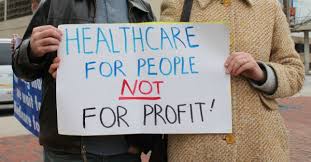
Our democracy is in real trouble – and always has been. The current crisis of ensuring a peaceful transition of power based on election results is very serious. However, there are other serious problems with our elections including voter suppression, gerrymandering, huge sums of money from wealthy interests, and the Electoral College. This post provides an historical overview and then focuses on the Electoral College and how to fix it.
(Note: If you find my posts too long to read on occasion, please just skim the bolded portions. Thanks for reading my blog! Special Note: The new, more user-friendly website for my blog is here.)
Our democracy is in real trouble – and always has been. The current crisis is ensuring a peaceful transition of power based on election results and it’s an immediate, very real, and very serious threat. The possibility of electing an authoritarian, dictatorial government in the next presidential election, one that would ignore the will of the voters in policy making and in future elections, is significant.
However, the problems with our elections go much deeper than simply honoring the will of the voters. Other serious problems include voter suppression (using many strategies), gerrymandered districts, huge sums of money in campaigns from wealthy individuals and corporations, and the Electoral College, which allows someone to win the presidency with far less than a majority of the votes.
Before delving into these issues and solutions for them, a little history and perspective are valuable. Our Founding Fathers had limited confidence in true democracy, despite their truly radical statement that all men are created equal. Even putting aside their limited vision that included only white men and no women, they put serious limits on a government supposedly operating based on the consent of the governed, which is reflected in multiple elements of the government they created. [1]
For example, U.S. Senators were appointed not elected (until a Constitutional Amendment in 1913), the Electoral College not the voters select the President, the Constitution is very difficult to amend, and the checks and balances of the three branches of government have a built in a bias toward the status quo and make major policy changes difficult. Furthermore, elections are winner take all; proportional representation (to ensure that minority voices are included in government) is not included.
In part this was because the Founding Fathers were designing a government for a small, agrarian country and could not envision the demands on government of today’s complex, fast changing society and world. They created a government where major policy changes are difficult unless there is a strong, broad consensus – and it’s painfully obvious how difficult that is to achieve these days.
The national government today is unstable because it often does not respond expeditiously to the will of the voters. This is typical of political systems where a strong president is elected separately from the legislative branch and where the legislative branch has two equally powerful chambers. This structure and the status quo bias of the government’s checks and balances make responsiveness to voters difficult. Voters quickly get frustrated with the inability of the officials they have just elected to respond to their wishes and therefore tend to vote for the other party in the next election.
In the national elections since 2006, party control of at least one chamber of Congress or the presidency has changed hands in every election except in 2012 (when President Obama was re-elected, Democrats maintained control of the Senate, and Republican maintained control of the House). Since 1980, there’s been a politically divided federal government over 70% of the time. In other words, the presidency and both chambers of Congress have been held by the same party less than 30% of the time. Therefore, it’s been rare that either party has been able to definitively advance its policy agenda.
Winner-take-all elections (as opposed to proportional representation in multi-candidate districts) are a major reason the U.S. has two party politics and a fluctuation of control back and forth. Other parties have little chance of electing any of their candidates and, therefore, are seen as spoilers, not serious options, in elections.
When democratic governments have been setup around the world, including in U.S.-led efforts after World War II and the war in Iraq, the U.S. model has not typically been used. Of the 78 relatively stable democracies in the world, only four use the U.S. model of a strong, head-of-government president and a legislature that are elected in separate voting in winner-take-all elections (U.S., Ghana, Liberia, and Sierra Leone).
The more frequent model for democracies is a parliamentary system. In a parliamentary system the head of the government, usually the prime minister, is the leader of the party or coalition that controls the parliament (i.e., the legislative body). (There is typically only one legislative chamber and if there is a second one, it typically has very limited power.) The president is typically a largely ceremonial figurehead (i.e., a head of state rather than a head of government). If the governing party or coalition in parliament cannot pass its policy agenda, an election is usually quickly held to elect a parliament that can advance its policy agenda.
The Electoral College system of selecting the U.S. President is particularly undemocratic and unstable. A state-based, winner-take-all model prevails in awarding Electoral College votes to the presidential candidates. (Only two states, Maine and Nebraska, split their electors between the presidential candidates.) What this means is that the presidential election is decided in a small number of “swing” states (typically four to maybe 12) by the tiny share of the overall electorate in those states who are the “swing” voters (about 400,000 voters or ¼ of one percent of the total votes cast of roughly 160 million). Moreover, because each state’s electoral votes are the sum of its number of U.S. Representative and Senators, the Electoral College votes are far from the democratic one person one vote standard. Most dramatically, each California Elector represents more than 700,000 people while each Wyoming Elector represents fewer than 200,000 people.
The easiest way to fix the Electoral College problem is to get states with a majority of the Electoral College votes to pass a National Popular Vote (NPV) law. This law simply states that the state’s electoral college votes will go to the presidential candidate with the most popular votes nationally. However, the law won’t go into effect in any state until enough states have passed it to make up a majority of the Electoral College votes (i.e., 270 votes). So far, it has been enacted in 17 states and Washington, D.C., which adds up to 209 electoral college votes. (D.C. has 3 votes even though it has no votes in Congress.) So, only 61 more votes from as few as five more states are needed for NPV to go into effect. In eight states with 80 electoral college votes, it has passed either one or both chambers of the state legislature. You can see the status of NPV in your state here.
If your state is one that hasn’t passed NPV, particularly if it’s one of the states where at least one chamber of the legislature has passed it, please contact your state legislators and urge them to pass it. There’s a nice one-page description of NPV and its status that you may find of interest or want to share with your state legislators here.
There will be more on the challenges facing our democracy and ways to strengthen it in future posts.
[1] Dayen, D., 1/29/24, “America is not a democracy,” The American Prospect (https://prospect.org/politics/2024-01-29-america-is-not-democracy/)










